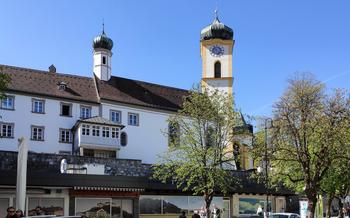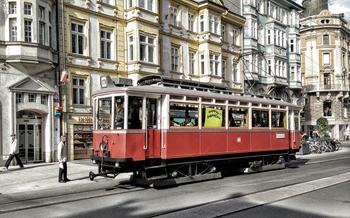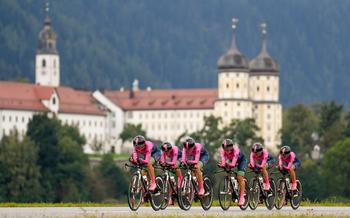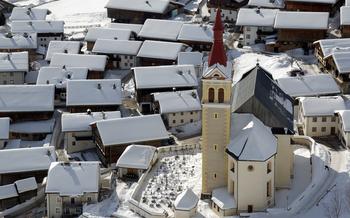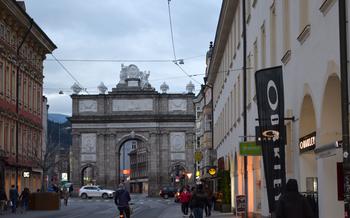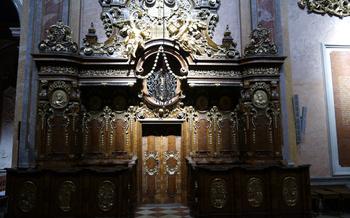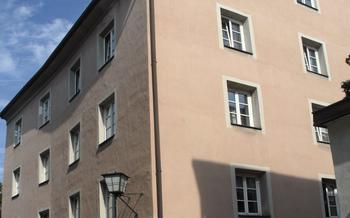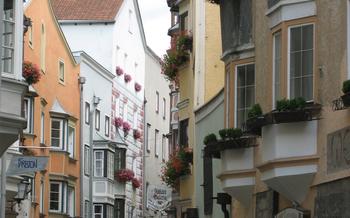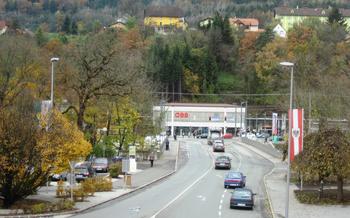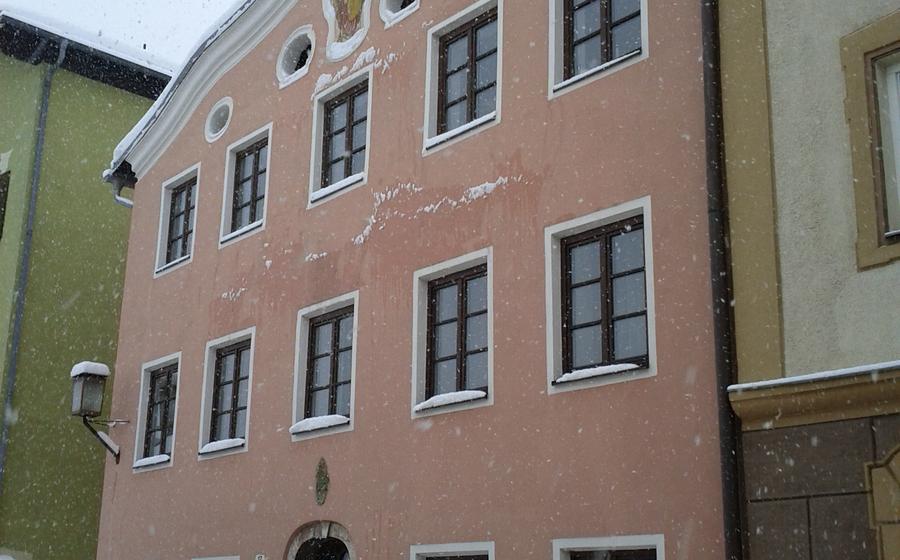
St. Georgenkirche
- St. Georgenkirche in Schwaz, Austria: A Historical Gem
- Captivating Architectural Masterpiece
- Journey Through Time: A Walk Through History
- A Sanctuary of Faith and Spirituality
- Unveiling the Secrets of the Frescoes
- Exploring the Church's Interior
- Witnessing the Beauty of Stained Glass
- Unearthing the Crypts and Catacombs
- Strolling Through the Picturesque Town of Schwaz
- Planning Your Visit: Essential Information
- Stepping Back in Time: Historical Reenactments
- Capturing the Perfect Shot: Photography Tips
- Souvenirs and Mementos: A Piece of History
- Insider Tip: Unveiling Hidden Treasures
St. Georgenkirche in Schwaz, Austria: A Historical Gem
Nestled in the picturesque town of Schwaz, Austria, the St. Georgenkirche stands as a testament to the region's rich history and religious heritage. Constructed in the 15th century, this magnificent Gothic-style church has witnessed centuries of devotion, architectural innovation, and cultural significance.
The church's origins can be traced back to the mining industry that flourished in Schwaz during the Middle Ages. As the town prospered, its inhabitants sought to build a grand church that would reflect their newfound wealth and piety. The construction of St. Georgenkirche began in 1460 under the patronage of Emperor Frederick III, and it was completed in 150
Over the centuries, the church has undergone several renovations and expansions. In the 17th century, the nave was extended, and the Baroque-style onion-shaped dome was added to the tower. The interior was also embellished with intricate frescoes, sculptures, and altars, transforming the church into a true masterpiece of sacred art.
St. Georgenkirche is not just a historical monument but also a living place of worship. It serves as the parish church for the Catholic community of Schwaz and hosts regular masses, weddings, and other religious ceremonies. The church's religious significance is further enhanced by the presence of several sacred relics, including a fragment of the True Cross and a statue of the Virgin Mary that is said to have miraculous powers.
Captivating Architectural Masterpiece
The St. Georgenkirche stands as a testament to the artistry and skill of medieval architects. Its Gothic-style design is characterized by pointed arches, ribbed vaults, and flying buttresses. The exterior is adorned with intricate stone carvings depicting biblical scenes and mythical creatures.
The interior is equally impressive, with stunning stained-glass windows that bathe the space in a kaleidoscope of colors. These windows depict biblical scenes, saints, and other religious figures. The intricate details and vibrant hues create a sense of awe and wonder.
The church also boasts unique frescoes that cover the walls and ceiling. These frescoes depict scenes from the life of Christ, the Virgin Mary, and other saints. The vivid colors and expressive figures bring the stories to life, creating a captivating visual narrative.
The St. Georgenkirche is a true masterpiece of Gothic architecture. Its stunning beauty and intricate details make it a must-see for anyone visiting Schwaz.
Journey Through Time: A Walk Through History
St. Georgenkirche stands as a testament to Schwaz's rich history. Its walls whisper tales of the past, echoing with the footsteps of pilgrims, royalty, and ordinary townsfolk. In its embrace, the church holds stories of marriages, baptisms, and funerals, bearing witness to the joys and sorrows of generations.
As you wander through the church's hallowed halls, you'll encounter artifacts and documents that transport you back in time. Admire the ancient baptismal font, where countless infants have been welcomed into the Christian faith. Marvel at the meticulously preserved marriage registers, recording the unions of countless couples who pledged their love within these sacred walls.
Don't miss the interactive exhibits and displays that bring history to life. Immerse yourself in multimedia presentations that recount the church's role in major historical events. Learn about the influential figures who have graced its doorsteps, leaving an indelible mark on Schwaz's tapestry.
A Sanctuary of Faith and Spirituality
The St. Georgenkirche stands as a testament to the deep-rooted faith and spirituality that have permeated Schwaz throughout its history. For centuries, it has served as a place of worship, pilgrimage, and spiritual reflection for the local community and visitors alike.
The church's religious significance is evident in its designation as a pilgrimage site. Devout believers from near and far have flocked to the St. Georgenkirche to seek solace, guidance, and divine intervention. The church houses sacred relics and devotional objects that are believed to possess miraculous powers and attract a steady stream of pilgrims.
Within the church's hallowed walls, an atmosphere of peace and tranquility envelops visitors. The soft glow of candles, the intricate frescoes depicting biblical scenes, and the poignant melodies of the organ create an ambiance conducive to contemplation and spiritual connection. The church's acoustics are renowned for their clarity and resonance, making it an ideal setting for concerts, recitals, and other musical performances that uplift the soul.
Unveiling the Secrets of the Frescoes
The St. Georgenkirche is renowned for its exquisite frescoes, which adorn the walls and ceilings with vibrant colors and intricate details. These mesmerizing artworks depict biblical scenes, historical events, and allegorical representations, offering a glimpse into the religious and cultural history of Schwaz.
One of the most striking frescoes is the "Last Judgment", located above the main altar. This awe-inspiring depiction of Christ separating the righteous from the wicked serves as a reminder of the consequences of one's actions and the importance of leading a virtuous life.
Another notable fresco is the "Life of St. George", which narrates the legendary tale of the saint's battle with the dragon. This captivating story of bravery and faith unfolds in a series of vivid panels, showcasing St. George's triumph over evil.
The frescoes in the St. Georgenkirche are not merely decorative elements; they serve as a powerful tool for teaching and inspiration. Through their symbolic imagery and biblical references, these artworks convey important moral messages and encourage contemplation and reflection.
To fully appreciate the artistry and symbolism of the frescoes, it is recommended to take a guided tour or use an audio guide. These resources provide valuable insights into the stories depicted, the techniques used by the artists, and the historical context of the artworks.
Exploring the Church's Interior
Stepping inside the St. Georgenkirche, visitors are greeted by a breathtaking display of intricate details and craftsmanship. The church's interior is a testament to the skill and devotion of the artisans who created it. The vaulted ceilings, supported by slender columns, create a sense of spaciousness and grandeur. The walls are adorned with frescoes, vibrant paintings that depict scenes from the Bible and the lives of the saints.
The main altar, a masterpiece of Gothic art, is a focal point of the church. It is intricately carved with scenes from the life of Christ, and its golden hues add a touch of opulence to the sanctuary. The church also features several side altars, each dedicated to a different saint or event. These altars are adorned with paintings, sculptures, and other works of art that reflect the rich history and traditions of the church.
The pulpit, located on the left side of the nave, is another highlight of the church's interior. It is made of carved wood, and its intricate details depict scenes from the Bible. The pulpit is a testament to the skill of the craftsmen who created it, and it serves as a reminder of the church's role as a center of teaching and preaching.
The stained-glass windows, which depict scenes from the Bible and the lives of the saints, add a touch of color and light to the church's interior. The windows are a beautiful example of the Gothic style, and they contribute to the overall sense of awe and inspiration that the church evokes.
The St. Georgenkirche is a treasure trove of art and history. Its interior is a testament to the skill and devotion of the artisans who created it. Visitors to the church can spend hours exploring the intricate details of the frescoes, sculptures, and other works of art that adorn its walls and altars. The church is a place of beauty and inspiration, and it is a must-see for anyone visiting Schwaz.
Witnessing the Beauty of Stained Glass
The St. Georgenkirche boasts some of the most captivating stained-glass windows in the region. These magnificent works of art, meticulously crafted by skilled artisans, are a testament to the artistry and devotion that went into the creation of this sacred space.
As sunlight streams through these vibrant windows, the interior of the church is illuminated with a kaleidoscope of colors, casting an ethereal glow upon the stone walls. Each window tells a unique story, depicting scenes from the Bible, the lives of saints, and significant events in the history of Christianity.
The colors used in the stained glass are rich and varied, creating a sense of depth and dimension. Deep blues, fiery reds, and golden yellows dance together, harmoniously blending to form intricate patterns and motifs.
The imagery depicted in these windows is both awe-inspiring and thought-provoking, inviting viewers to contemplate the mysteries of faith and the profound teachings of the Christian tradition. From the delicate depiction of saints and angels to the dramatic portrayal of biblical narratives, each window is a masterpiece in its own right.
Visitors to the St. Georgenkirche are encouraged to take a moment to admire the intricate details and symbolism embedded within each stained-glass window. Whether you're an art enthusiast, a history buff, or simply someone seeking spiritual inspiration, these windows offer a glimpse into the beauty and wonder of the divine.
Unearthing the Crypts and Catacombs
Beneath the St. Georgenkirche, a hidden world awaits discovery—the crypts and catacombs. These underground spaces, steeped in history and mystery, offer a glimpse into the past and the lives of those who came before us.
The crypts, once used as burial chambers for the town's elite, are a testament to Schwaz's rich history. Here, visitors can marvel at the well-preserved tombs and learn about the lives of the prominent figures who shaped the town's destiny.
Descending further into the depths, visitors will find the catacombs, a network of underground tunnels that once served as a refuge for early Christians during times of persecution. These eerie yet fascinating spaces are lined with niches where the remains of the faithful were laid to rest.
Excavations and research have uncovered fascinating artifacts and provided insights into the lives of those who sought solace and protection within the catacombs. Guided tours are available, allowing visitors to delve deeper into the history and significance of these hidden chambers.
Whether you're a history buff, an architecture enthusiast, or simply seeking a unique and immersive experience, exploring the crypts and catacombs beneath the St. Georgenkirche is an unforgettable journey that will leave you with a profound appreciation for the past.
Strolling Through the Picturesque Town of Schwaz
Nestled amidst breathtaking Alpine scenery, the town of Schwaz exudes a charm that captivates visitors from the moment they arrive. With a rich history dating back to the Middle Ages, Schwaz boasts a treasure trove of architectural wonders, cultural attractions, and natural beauty.
Strolling through the cobblestone streets, visitors can admire the well-preserved medieval buildings, each with its own unique story to tell. The town square, Marktplatz, is the heart of Schwaz, where locals and tourists alike gather to soak up the vibrant atmosphere. Here, visitors can find charming cafes, inviting restaurants, and shops selling local crafts and souvenirs.
One of the must-visit attractions in Schwaz is the Silberbergwerk Schwaz, a former silver mine that played a crucial role in the town's prosperity. Visitors can embark on a guided tour of the mine, exploring its tunnels and learning about the history of silver mining in the region.
Nature enthusiasts will delight in the stunning hiking trails that lead to the surrounding mountains, offering panoramic views of the Tyrolean Alps. The Kellerjoch mountain range, located just a short distance from Schwaz, is a paradise for hikers of all levels, with trails that wind through lush forests and alpine meadows.
After a day of exploration, visitors can relax and unwind in one of Schwaz's many restaurants or cafes. The town offers a variety of culinary delights, from traditional Tyrolean dishes to international cuisine. Be sure to sample some of the local specialties, such as Käsespätzle (cheese noodles) or Tiroler Gröstl (fried potatoes with meat and onions).
Whether you're a history buff, a nature lover, or simply seeking a charming town to explore, Schwaz has something to offer everyone. With its rich heritage, stunning scenery, and warm hospitality, this picturesque town is sure to leave a lasting impression. So, take a stroll through the streets of Schwaz and discover its hidden treasures for yourself.
Planning Your Visit: Essential Information
To ensure a smooth and enriching visit to St. Georgenkirche, it's essential to plan ahead. Mass times vary throughout the week, so it's advisable to check the church's website or local listings for the most up-to-date schedule. Admission to the church is generally free, but donations are welcome to support its upkeep and preservation. Visitors with disabilities should note that the church is wheelchair accessible, with ramps and elevators available.
When it comes to capturing the beauty of St. Georgenkirche, photography enthusiasts should be mindful of the church's guidelines. Flash photography is not permitted within the church as it can damage the delicate artwork and frescoes. Tripods are also discouraged to prevent any obstruction or disruption to other visitors.
Stepping Back in Time: Historical Reenactments
Schwaz comes alive with the spirit of the past as it hosts historical reenactments and festivals throughout the year. These events transport visitors back to the Middle Ages, offering a glimpse into the town's rich history and traditions. Dressed in authentic costumes, actors and performers bring to life scenes from Schwaz's past, showcasing the daily lives, customs, and celebrations of the era. Visitors can witness jousting tournaments, medieval markets, and traditional dances, immersing themselves in the vibrant atmosphere of a bygone era.
One of the most popular reenactments is the Schwazer Ritterspiele, held annually in July. This festival features spectacular performances, music, and feasts, recreating the grandeur of medieval chivalry. Participants demonstrate their skills in archery, sword fighting, and horsemanship, while artisans showcase their crafts, creating a lively and authentic medieval village.
These historical reenactments offer a unique opportunity to experience the past firsthand, providing visitors with a deeper understanding of Schwaz's heritage and the lives of its people centuries ago.
Capturing the Perfect Shot: Photography Tips
St. Georgenkirche's stunning architecture, intricate frescoes, and stained-glass windows present a photographer's paradise. To capture the church's grandeur, consider the following tips:
-
Embrace the Light: Visit the church during the golden hours of sunrise or sunset when the natural light casts a warm glow, enhancing the church's beauty.
-
Find the Best Angles: Experiment with different angles to capture unique perspectives. The church's exterior offers a majestic view, while the interior reveals hidden details.
-
Focus on Details: Zoom in on the intricate carvings, frescoes, and stained-glass windows. These details add depth and character to your photographs.
-
Compose Your Shot: Pay attention to composition, ensuring the church is the focal point and the background complements the subject.
-
Use a Tripod: Utilize a tripod for stability, especially when shooting in low-light conditions or capturing long exposures.
-
Experiment with Black and White: Consider converting your images to black and white. This can create a timeless and dramatic effect, emphasizing the church's architectural features.
-
Share Your Masterpieces: Don't forget to share your stunning captures on social media, using relevant hashtags and tagging the church's official accounts.
Souvenirs and Mementos: A Piece of History
As you depart from the awe-inspiring St. Georgenkirche, don't forget to take a piece of its history with you. The town of Schwaz offers a variety of souvenirs and mementos that will serve as lasting reminders of your visit. From intricate replicas of the church's stained-glass windows to delicate jewelry inspired by its Gothic architecture, there's something for every taste.
Visit local shops and boutiques to discover unique gifts and keepsakes that capture the essence of this historic site. Browse through hand-painted pottery featuring scenes from the church's frescoes, or select a beautifully crafted wooden figurine depicting a saint or angel. These mementos not only serve as cherished souvenirs but also support local artisans and businesses, ensuring that the legacy of St. Georgenkirche continues to thrive.
Insider Tip: Unveiling Hidden Treasures
St. Georgenkirche holds many secrets beyond what meets the eye. For the curious and adventurous, there are hidden passageways and chambers that offer a glimpse into the church's rich history. One such secret is the hidden staircase leading to the bell tower, where visitors can climb up for breathtaking panoramic views of Schwaz and the surrounding mountains. Another hidden gem is the crypt beneath the church, where visitors can explore the final resting places of notable figures from Schwaz's past. For those seeking a truly unique experience, guided tours are available that delve deeper into the church's hidden corners, revealing stories and legends that have been passed down through generations.
